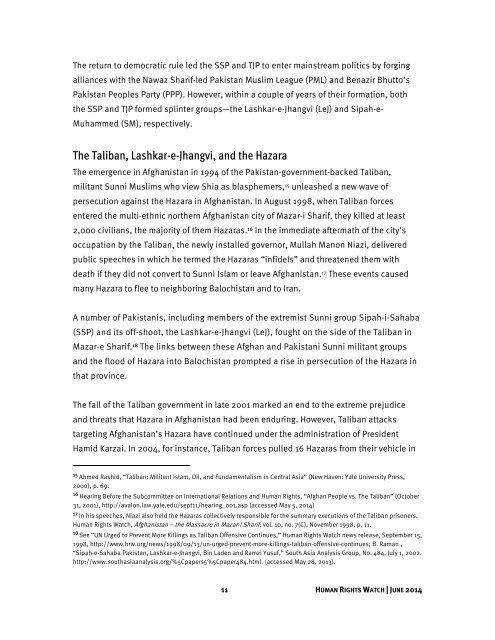pakistan0614_ForUplaod
pakistan0614_ForUplaod
pakistan0614_ForUplaod
You also want an ePaper? Increase the reach of your titles
YUMPU automatically turns print PDFs into web optimized ePapers that Google loves.
The return to democratic rule led the SSP and TJP to enter mainstream politics by forging<br />
alliances with the Nawaz Sharif-led Pakistan Muslim League (PML) and Benazir Bhutto’s<br />
Pakistan Peoples Party (PPP). However, within a couple of years of their formation, both<br />
the SSP and TJP formed splinter groups—the Lashkar-e-Jhangvi (LeJ) and Sipah-e-<br />
Muhammed (SM), respectively.<br />
The Taliban, Lashkar-e-Jhangvi, and the Hazara<br />
The emergence in Afghanistan in 1994 of the Pakistan-government-backed Taliban,<br />
militant Sunni Muslims who view Shia as blasphemers, 15 unleashed a new wave of<br />
persecution against the Hazara in Afghanistan. In August 1998, when Taliban forces<br />
entered the multi-ethnic northern Afghanistan city of Mazar-i Sharif, they killed at least<br />
2,000 civilians, the majority of them Hazaras. 16 In the immediate aftermath of the city's<br />
occupation by the Taliban, the newly installed governor, Mullah Manon Niazi, delivered<br />
public speeches in which he termed the Hazaras “infidels” and threatened them with<br />
death if they did not convert to Sunni Islam or leave Afghanistan. 17 These events caused<br />
many Hazara to flee to neighboring Balochistan and to Iran.<br />
A number of Pakistanis, including members of the extremist Sunni group Sipah-i-Sahaba<br />
(SSP) and its off-shoot, the Lashkar-e-Jhangvi (LeJ), fought on the side of the Taliban in<br />
Mazar-e Sharif. 18 The links between these Afghan and Pakistani Sunni militant groups<br />
and the flood of Hazara into Balochistan prompted a rise in persecution of the Hazara in<br />
that province.<br />
The fall of the Taliban government in late 2001 marked an end to the extreme prejudice<br />
and threats that Hazara in Afghanistan had been enduring. However, Taliban attacks<br />
targeting Afghanistan’s Hazara have continued under the administration of President<br />
Hamid Karzai. In 2004, for instance, Taliban forces pulled 16 Hazaras from their vehicle in<br />
15 Ahmed Rashid, “Taliban: Militant Islam, Oil, and Fundamentalism in Central Asia” (New Haven: Yale University Press,<br />
2000), p. 69.<br />
16 Hearing Before the Subcommittee on International Relations and Human Rights, “Afghan People vs. The Taliban” (October<br />
31, 2001), http://avalon.law.yale.edu/sept11/hearing_001.asp (accessed May 5, 2014)<br />
17 In his speeches, Niazi also held the Hazaras collectively responsible for the summary executions of the Taliban prisoners.<br />
Human Rights Watch, Afghanistan – the Massacre in Mazar-i Sharif, vol. 10, no. 7(C), November 1998, p. 11.<br />
18 See “UN Urged to Prevent More Killings as Taliban Offensive Continues,” Human Rights Watch news release, September 15,<br />
1998, http://www.hrw.org/news/1998/09/13/un-urged-prevent-more-killings-taliban-offensive-continues; B. Raman ,<br />
“Sipah-e-Sahaba Pakistan, Lashkar-e-Jhangvi, Bin Laden and Ramzi Yusuf,” South Asia Analysis Group, No. 484, July 1, 2002.<br />
http://www.southasiaanalysis.org/%5Cpapers5%5Cpaper484.html. (accessed May 28, 2013).<br />
11 HUMAN RIGHTS WATCH | JUNE 2014


